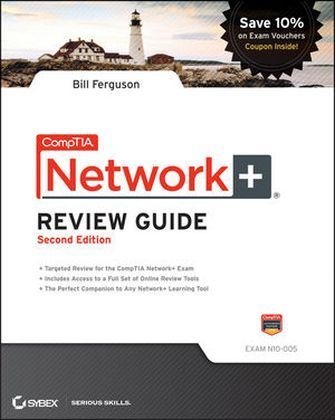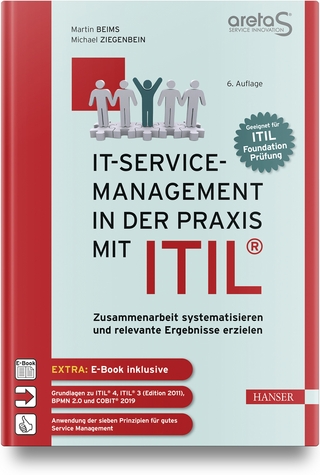
CompTIA Network+ Review Guide
John Wiley & Sons Inc (Verlag)
978-1-118-14862-4 (ISBN)
- Titel ist leider vergriffen;
keine Neuauflage - Artikel merken
Fast, focused review for the latest CompTIA Network+ Exam N10-005 CompTIA's Network+ certification is the leading non-vendor networking certification in the world and has become the standard certification for networking professionals. Make sure you're ready for CompTIA's new Network+ certification (exam N10-005) with this new edition of Sybex's CompTIA Network+ Review Guide. This concise guide is efficiently organized by exam objectives and covers all five exam domains. The book also includes 50 chapter review questions, as well as access to two online practice exams, and much more. It's the perfect companion to Sybex's CompTIA Network+ Study Guide, Second Edition or any Network+ study tool.
* Helps students prepare for the leading non-vendor-specific networking certification, CompTIA Network+ * This new edition is fully updated for Exam N10-005, the latest revision of the CompTIA Network+ exam * Conveniently organized by exam objectives for quick review * Features Exam Essentials in each chapter to help you focus on what you need to know for the exam * Provides access to practice exams, and other practice tools Review all Network+ Exam N10-005 exam objectives and reinforce your studies with CompTIA Network+ Review Guide, Second Edition.
Bill Ferguson, A+, Network+, Server+, Security+, has over 15 years of IT experience. He currently runs Parallel Connections and is an independent contractor, teaching classes worldwide. He also writes and produces technical training videos for Specialized Solutions, Virtual Training Company, and Palaestra Training Company. Bill has written several books, including the first edition of the CompTIA Network+ Review Guide.
Introduction xxi Chapter 1 Domain 1 Network Technologies 1 1.1 Compare the layers of the OSI and TCP/IP models 7 OSI model 7 TCP/IP model 8 Exam Essentials 10 1.2 Classify how applications, devices, and protocols relate to the OSI model layers 10 MAC addresses 10 IP Addresses 11 EUI-64 11 Frames 11 Packets 11 Switch 12 Router 13 Multilayer Switch 13 Hub 13 Encryption devices 14 Cable 14 NIC 14 Bridge 15 Exam Essentials 15 1.3 Explain the purpose and properties of IP addressing 15 Classes of addresses 16 Classless (CIDR) 18 IPv4 vs. IPv6 (formatting) 19 MAC address format 21 Subnetting 22 Multicast vs. unicast vs. broadcast 26 APIPA 26 Exam Essentials 27 1.4 Explain the purpose and properties of routing and switching 27 EIGRP 28 OSPF 28 RIP 28 Link state vs. distance vector vs. hybrid 29 Static vs. dynamic 29 Routing metrics 30 Next hop 30 Spanning Tree Protocol 31 VLAN (802.1q) 31 Port mirroring 32 Broadcast domain vs. collision domain 32 IGP vs. EGP 33 Routing tables 33 Convergence (steady state) 34 Exam Essentials 34 1.5 Identify common TCP and UDP default ports 35 Exam Essentials 36 1.6 Explain the function of common networking protocols 36 Transmission Control Protocol (TCP) 41 File Transfer Protocol (FTP) 41 User Datagram Protocol (UDP) 41 TCP/IP suite 42 Dynamic Host Configuration Protocol (DHCP) 42 Trivial File Transfer Protocol (TFTP) 42 Domain Name System (DNS) 42 Hypertext Transfer Protocol (HTTP) 43 Hypertext Transfer Protocol Secure (HTTPS) 43 Address Resolution Protocol (ARP) 43 Session Initiation Protocol (SIP) 44 Real-Time Transport Protocol (RTP) 44 Secure Shell (SSH) 44 Post Office Protocol Version 3 (POP3) 44 Network Time Protocol (NTP) 45 Internet Message Access Protocol version 4 (IMAPv4) 45 Telnet 45 Simple Mail Transfer Protocol (SMTP) 45 Simple Network Management Protocol 2/3 (SNMP 2/3) 46 Internet Control Message Protocol (ICMP) 46 Internet Group Multicast Protocol (IGMP) 46 Transport Layer Security (TLS) 47 Exam Essentials 47 1.7 Summarize DNS concepts and its components 47 DNS servers 47 DNS records 47 Dynamic DNS 48 Exam Essentials 48 1.8 Given a scenario, implement the following network troubleshooting methodology 48 Identify the problem 49 Establish a theory of probable cause 49 Test the theory to determine cause 50 Establish a plan of action to resolve the problem and identify potential effects 50 Implement the solution or escalate as necessary 50 Verify full system functionality and if applicable implement preventive measures 51 Document findings, actions, and outcomes 51 Exam Essentials 51 1.9 Identify virtual network components 51 Virtual Switches 52 Virtual Desktops 52 Virtual Servers 52 Virtual PBX 53 Onsite vs. Offsite 53 Network as a Service (NaaS) 53 Exam Essentials 54 Review Questions 55 Chapter 2 Domain 2 Network Installation and Configuration 57 2.1 Given a scenario, install and configure routers and switches 60 Routing tables 60 NAT 61 PAT 61 VLAN (trunking) 63 Managed vs. unmanaged 63 Interface configurations 63 PoE 65 Traffic filtering 65 Diagnostics 65 VTP configuration 65 QoS 66 Port mirroring 66 Exam Essentials 66 2.2 Given a scenario, install and configure a wireless network 67 WAP placement 67 Antenna types 67 Interference 67 Frequencies 68 Channels 68 SSID (enable/disable) 68 Wireless standards and Compatibility 69 Exam Essentials 69 2.3 Explain the purpose and properties of DHCP 70 Static vs. dynamic IP addressing 70 Reservations 71 Scopes 71 Leases 72 Options (DNS servers, suffixes) 72 Exam Essentials 72 2.4 Given a scenario, troubleshoot common wireless problems 73 Interference 73 Signal strength 73 Configurations 74 Incompatibilities 74 Incorrect channel 74 Latency 74 Encryption type 75 Bounce 75 SSID mismatch 75 Incorrect switch placement 75 Exam Essentials 76 2.5 Given a scenario, troubleshoot common router and switch problems 76 Switching loop 76 Bad cables/improper cable types 77 Port configuration 77 VLAN assignment 77 Mismatched MTU/MTU black hole 77 Power failure 78 Bad/missing routes 78 Bad modules (SFPs, GBICs) 78 Wrong subnet mask 78 Wrong gateway 78 Duplicate IP address 79 Wrong DNS 79 Exam Essentials 80 2.6 Given a set of requirements plan and implement a basic SOHO network 80 List of requirements 80 Cable length 81 Device types/requirements 81 Environment limitations 81 Equipment limitations 81 Compatibility requirements 82 Exam Essentials 82 Review Questions 83 Chapter 3 Network Media and Topologies 85 3.1 Categorize standard media types and associated properties 90 Fiber 90 Copper 91 Plenum vs. non-plenum 95 Media converters 96 Distance limitations and speed limitations 97 Broadband over powerline 98 Exam Essentials 98 3.2 Categorize standard connector types on network media 99 Fiber 99 Copper 101 Exam Essentials 105 3.3 Compare and contrast different wireless standards 106 802.11 a/b/g/n standards 106 Exam Essentials 108 3.4 Categorize WAN technology types and properties 108 Types 108 Properties 116 Exam Essentials 118 3.5 Describe different network topologies 118 Exam Essentials 123 3.6 Given a scenario, troubleshoot common physical connectivity problems 124 Exam Essentials 126 3.7 Compare and contrast different LAN technologies 126 Exam Essentials 129 3.8 Identify components of wiring distribution 130 Exam Essentials 132 Review Questions 133 Chapter 4 Network Management 135 4.1 Explain the purpose and features of various network appliances 138 Load balancer 138 Proxy server 139 Content filter 139 VPN Concentrator 140 Exam Essentials 140 4.2 Given a scenario, use the appropriate hardware tools to troubleshoot connectivity issues 140 Cable tester 140 Cable certifier 141 Crimper 141 Butt set 142 Toner probe 142 Punch down tool 143 Protocol analyzer 144 Loop back plug 144 TDR 144 OTDR 145 Multimeter 145 Environmental monitor 146 Exam Essentials 146 4.3 Given a scenario, use the appropriate software tools to troubleshoot connectivity issues 147 Protocol analyzer 147 Throughput testers 147 Connectivity software 148 Ping 148 Tracert/traceroute 148 Dig 150 Ipconfig/ifconfig 150 Nslookup 151 Arp 152 Nbtstat 154 Netstat 155 Route 156 Exam Essentials 158 4.4 Given a scenario, use the appropriate network monitoring resource to analyze traffic 158 SNMP 159 SNMPv2 159 SNMPv3 159 Syslog 160 System logs, History logs, and General logs 160 Traffic analysis 160 Network sniffer 161 Exam Essentials 161 4.5 Describe the purpose of configuration management documentation 162 Wire schemes 162 Network maps 163 Documentation 163 Cable management 163 Asset management 164 Baselines 164 Change management 164 Exam Essentials 165 4.6 Explain different methods and rationales for network performance optimization 165 Methods 165 Reasons 167 Exam Essentials 169 Review Questions 170 Chapter 5 Domain 5 Network Security 173 5.1 Given a scenario, implement appropriate wireless security measures 177 Encryption Protocols 177 MAC address filtering 179 Device placement 179 Signal strength 179 Exam Essentials 180 5.2 Explain the methods of network access security 180 ACL 180 Tunneling and encryption 182 Remote Access 184 Exam Essentials 187 5.3 Explain the methods of user authentication 188 PKI 188 Kerberos 189 AAA 190 Network access control 191 CHAP 191 MS-CHAP 192 EAP 192 Two-factor authentication 192 Multifactor authentication 193 Single sign-on 193 Exam Essentials 193 5.4 Explain common threats, vulnerabilities, and mitigation techniques 194 Wireless 195 Attacks 197 Mitigation techniques 200 Exam Essentials 201 5.5 Given a scenario, install and configure a basic firewall 201 Types 202 Port Security 202 Stateful inspection vs. packet filtering 203 Firewall rules 203 NAT/PAT 204 DMZ 204 Exam Essentials 205 5.6 Categorize different types of network security appliances and methods 205 IDS and IPS 206 Vulnerability scanners 207 Methods 208 Exam Essentials 208 Review Questions 210 Appendix A Answers to Review Questions 213 Chapter 1: Domain 1 Network Technologies 214 Chapter 2: Domain 2 Network Installation and Configuration 215 Chapter 3: Network Media and Topologies 216 Chapter 4: Network Management 217 Chapter 5: Domain 5 Network Security 219 Appendix B About the Additional Study Tools 221 Additional Study Tools 222 Sybex Test Engine 222 Electronic Flashcards 222 PDF of Glossary of Terms 222 Adobe Reader 222 System Requirements 223 Using the Study Tools 223 Troubleshooting 223 Customer Care 224 Index 225
| Zusatzinfo | Illustrations |
|---|---|
| Verlagsort | New York |
| Sprache | englisch |
| Maße | 188 x 230 mm |
| Gewicht | 434 g |
| Themenwelt | Mathematik / Informatik ► Informatik ► Netzwerke |
| Informatik ► Weitere Themen ► Zertifizierung | |
| Sozialwissenschaften ► Pädagogik | |
| ISBN-10 | 1-118-14862-2 / 1118148622 |
| ISBN-13 | 978-1-118-14862-4 / 9781118148624 |
| Zustand | Neuware |
| Haben Sie eine Frage zum Produkt? |
aus dem Bereich


